“I put up a crappy website and started creating content. In just 7 weeks, somehow we had 400 ticket sales, and we made $50,000.”
Sam Parr
In 2014, the man behind the hotdog stand business “Southern Sam’s: Weiners as Big as a Baby’s Arm” decided to organize a conference for non-technical founders.
Sam had never before organized or even been to a conference. He had no personal connections with anyone qualified to speak at such a conference. In this letter, I’ll show you EXACTLY how Sam did this, including a spreadsheet breaking down what his exact expenses and sponsorship revenues were at the end.
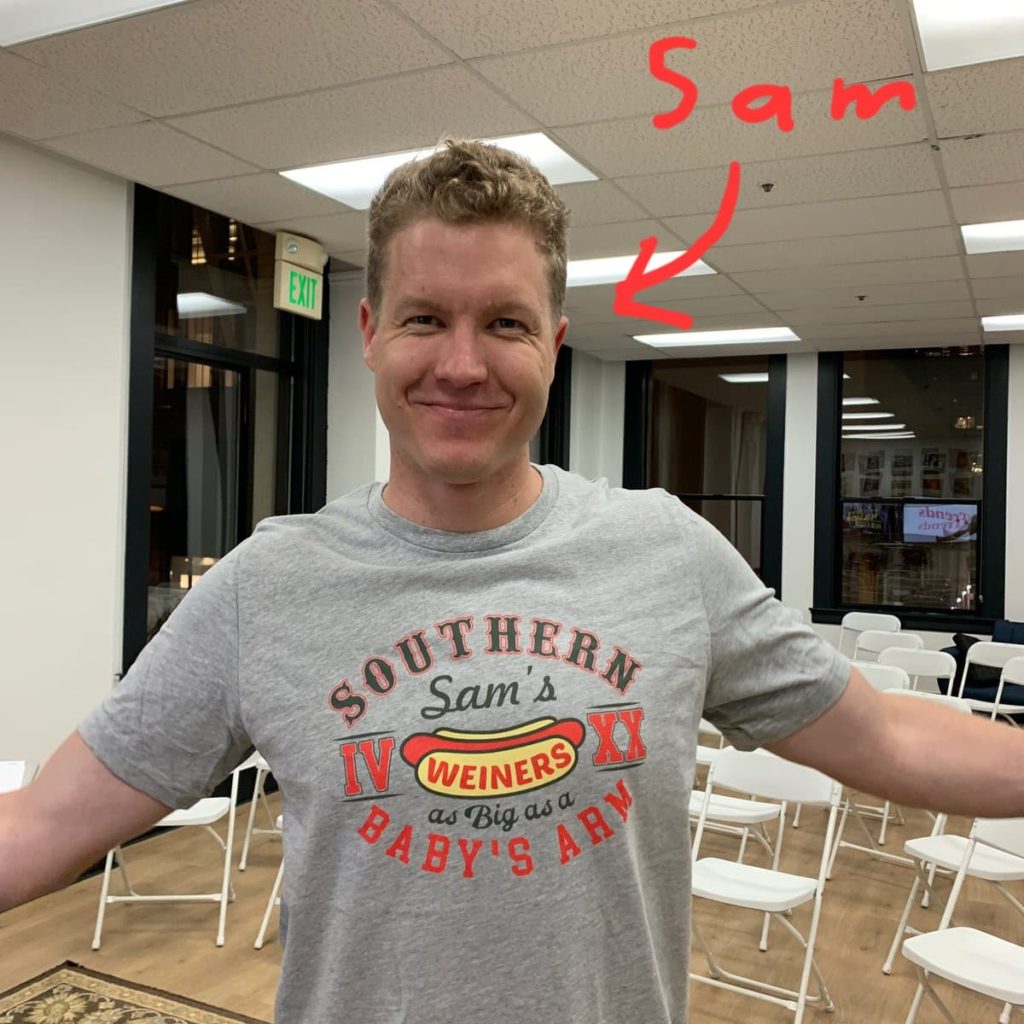
Armed with nothing more than youth and blissful ignorance, Sam began trying to recruit founders of successful companies to speak at his conference. In his first pitches, Sam tried to convince them to come by explaining how fun the event would be or how they could grow their business because there would be an audience of 400 people. That strategy got him exactly nowhere.
So he made two changes to his pitch.
First, Sam increased the audience size with only a marginal increase to his costs by creating a Udemy course that would have video from the event. He managed to get a couple thousand people signed up for the course.
Second, he stopped telling founders how much business they would generate from the event. Instead, he asked them to “come spread your company’s gospel” to the conference’s audience of smart enterprising “do-ers”.
By simple word choice (religious words and phrasing), Sam’s message flattered prospective speakers by making them “god-level” business authorities. Even more importantly, the focus was no longer on the questionable amount of business that a small conference could realistically generate, given that the audience wasn’t the target customer for most of the speakers’ companies. Instead, the focus was placed on the much more valuable fact that the audience was composed of intelligent, action-oriented business people. This matters because one of the big issues that CEOs of growing startups face is hiring top talent. A few customers wouldn’t move the needle for these speakers, but a couple good recruits could. There is a reason, after all, that startups sometimes pay recruiters upwards of $30k for a single hire. (Note: After the first HustleCon, Sam realized the full extent to which this was true. He made the recruiting value proposition even more explicit when approaching potential speakers for the second HustleCon by offering to post any open job positions of a speaker’s company on the HustleCon website).
Closing Speakers
Sam’s effectiveness in closing speakers went from zero to IMPRESSIVE after implementing those two changes.
He still got some rejections. He still had to be persistent–sometimes following up with 5-10 emails before getting a response. But that’s the price of getting the attention of someone who’s very busy and successful when you’re a nobody, and it’s a pretty low price if you ask me. And it worked!
Sam got 12 successful founders to agree to come speak at his conference within a few weeks, even though none of them had ever heard of him or his conference before. And to make it even more impressive: He didn’t pay any of them, and only paid the travel costs for one of them.
Here’s one of the real emails he sent to the founder of Pandora (he actually sent this one for the second HustleCon, but it’s the same strategy he used for the first one):
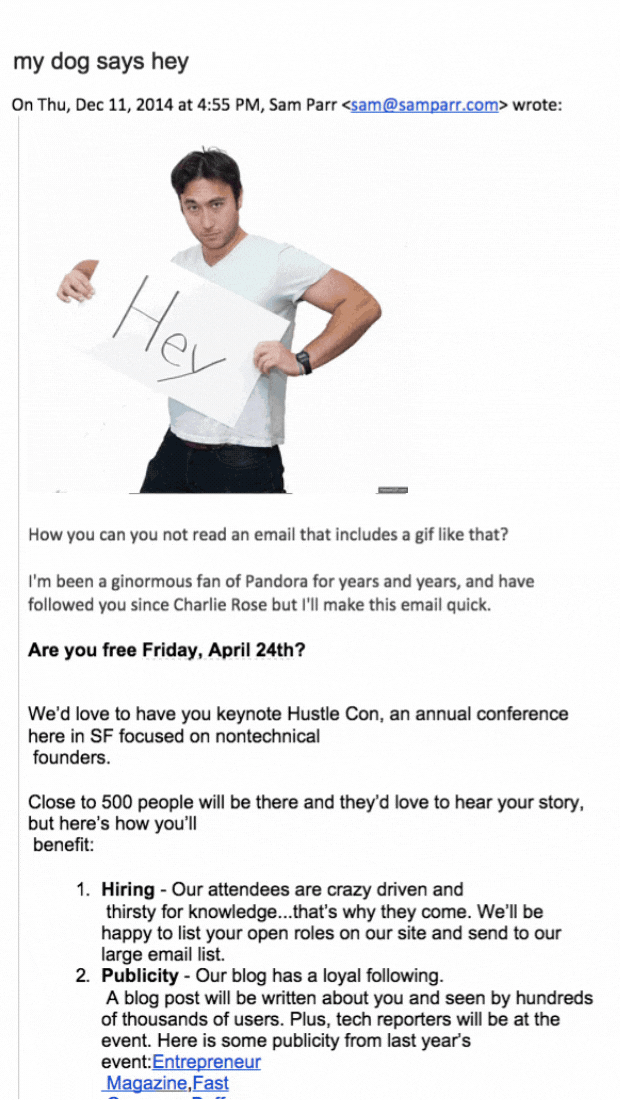
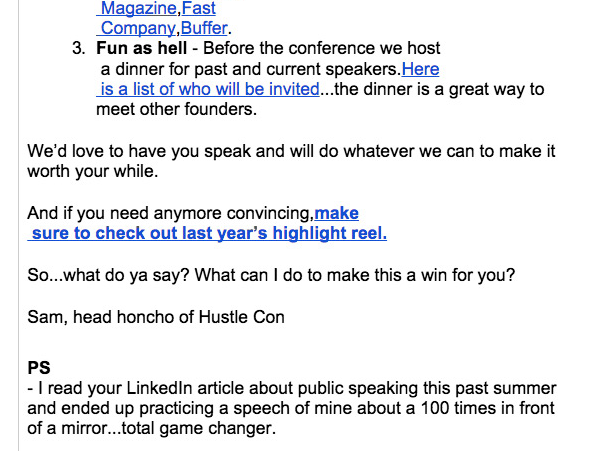
From the subject line to the personalized GIF to the “PS” message which communicates that Sam values and follows the advice of recipient, this is a perfect example of what Sam calls an “irresistable email”. But it still needed several follow-ups before it got a response.
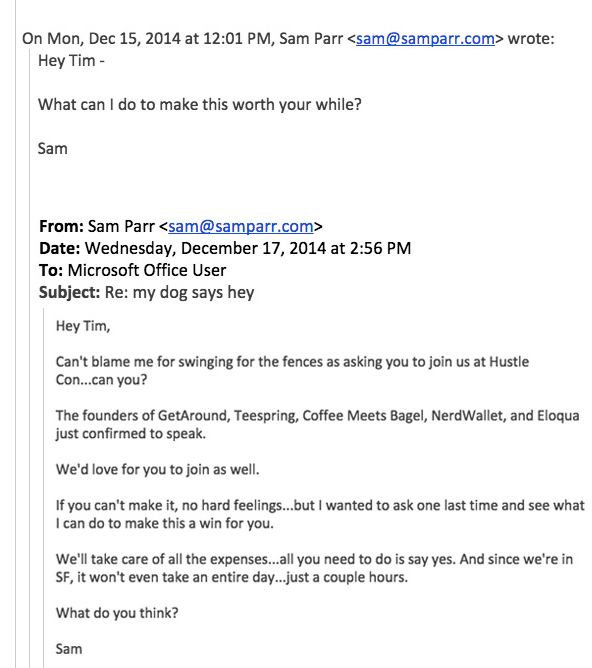
But eventually the same persistence that drove Sam’s massive wiener business to success also brought Tim Westergren around!
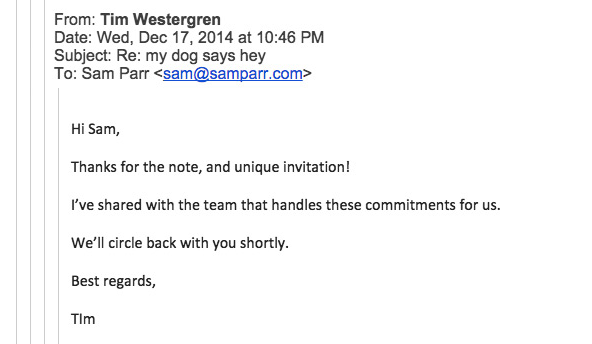
How to Bypass Planning Problems
There are two main ways to make money from conferences: selling tickets and selling sponsorships.
However, many people who try to host a conference never get off the ground because conference planning can easily run into circular dependencies with regard to financing and negotiations.
- How do you attract speakers without an audience, but also how do you sell tickets to build an audience without knowing who the speakers will be?
- How can you choose a venue without knowing how many tickets you’ll sell, but also how can you know how many tickets you even can sell before you know the venue size?
- How do you know what speakers you can get without knowing your budget to pay speakers, but also how can you know that budget without knowing how many tickets you’ll sell or how many sponsorships you’ll get?
- How do you get sponsorhips without knowing speakers or audience size, but also how do you hire speakers without money from sponsorships?
- How can you create an overall budget without knowing food costs, and how can you know food costs without knowing the audience size, and how can you know audience size without knowing venue size, and how can you know venue size without knowing the overall budget?
Sam cut through these issues like a hot knife through a hotdog.
- Sam chose a relatively small maximum number of attendees (400), chose a venue just large enough to accomodate this number which required only a cheap deposit ($500), and spoke to potential speakers and sponsors as if all 400 tickets would sell.
- Because Sam provided value to the speakers through the recruitment opportunity previously mentioned, he didn’t actually need to pay any of the speakers. That eliminated all the dependencies between budgeting and getting speakers. Sam did reach out to some prospective speakers who eventually said they would only speak for a fee, but he simply didn’t accept any speakers who required payment. This meant he turned down some famous people like James Altucher, but there are always more fish.
- Sam spent a little under a month emailing potential speakers before launching the HustleCon website. By the time he launched and started advertising tickets for sale, he already had two speakers engaged. At that point, he advertised the conference with phrases like:
“…our amazing speakers for this year’s conference… these people are gonna blow your mind… I’m talking about guys like Rick Marini, who sold his business Tickle.com for $100+ million dollars. And Heitan Shah, who founded both KISSmetrics and Crazy Egg…two immensely successful startups.”
This type of marketing copy was effective at selling tickets even before most of the speakers were known.
Sales Strategy
Sam’s strategy for selling tickets was pretty straightforward: Emails and blog articles. Sam published one blog article about each speaker (he only wrote a couple himself and repurposed existing posts, with permission, from the speakers’ blogs for the rest). He then sent out a 12-email sequence to each person he was able to add to his mailing list. Each email in the sequence consisted of a short funny story about one of the speakers, a link to the article, and a call-to-action link to purchase tickets at the end of each email and article.
To get as many emails as possible, Sam used every tactic in the book. He shared each blog post in dozens of Facebook groups. He gave away 50 of the 400 tickets to Facebook friends who had the most Facebook followers in exchange for them sharing the HustleCon link as their status. He also harnessed the power of existing lists by messaging dozens of Meetup group organizers and bloggers who he knew had huge lists and offered them the opportunity to share a 35% discount with their subscribers. He took the same approach by contacting entrepreneur-focused companies with large newsletters such as StartupDigest, WebWallflower, and Fetch.
Sponsorship Strategy
Sam raised about $19,250 from sponsors, although later when he had more experience he said he thought he undercharged and probably could have done around $50,000.
Sam classifies sponsors into 2 categories: those who want brand exposure and those who want leads.
Big companies like Google and Amazon have huge marketing budgets to spend on conferences. Those guys aren’t focused on getting a specific return on their investment but rather on building brand awareness.
Small companies like recruiting firms, startups, and local small businesses on the other hand are looking for a return on their investment.
Here’s Sam’s process for contacting potential sponsors:
- Make a spreadsheet of 120 companies you like who have sponsored 2 or more conferences in the past. Record the head of marketing’s email address of each.
- Email each company to set up a call.
- During the call, don’t focus on actually trying to get sponsorship money but rather on getting them EXCITED about the conference. This led to many companies buying at least one ticket for an employee even if they didn’t decide to sponsor.
Through that process, Sam got about 20 calls with potential sponsors. Many of them sent at least one employee, and seven actually bought a sponsorship package.
Financial Breakdown
HustleCon brought in $37,594 in ticket sales and $19,250 in sponsorship package sales for a total of $56,844 in revenue.
Total expenses came in at $16,631 which left Sam with a hefty profit of $40,213. A detailed breakdown of expenses and sponsorship package amounts is shown in the spreadsheet below.
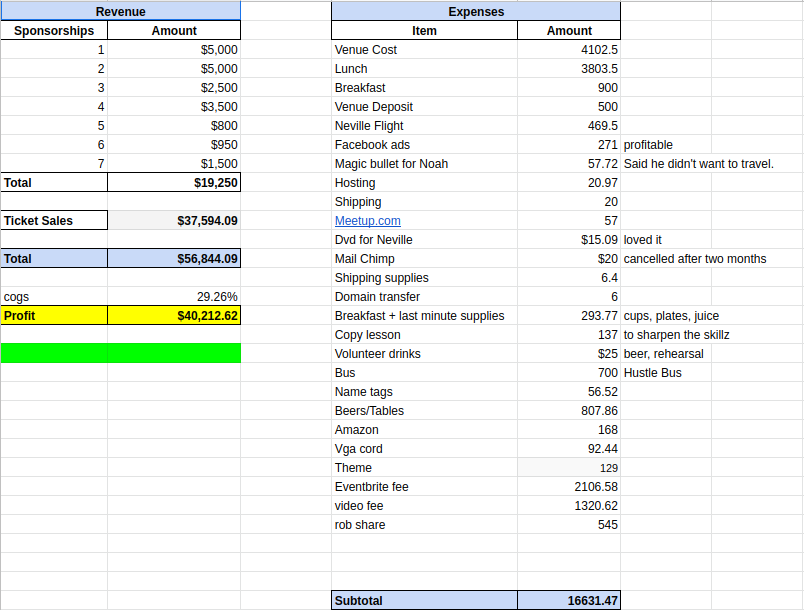
To achieve this, Sam spent about 2 months of 40-hour workweeks on this event plus one more month beforehand when he was just sending out emails to prospective speakers which is doable in under an hour a day. He also recruited 25 volunteers to work the event for free (this turns out to be much more common than you may expect in the event world). Volunteers are often motivated by free entry to the event and the potential “premium” access to speakers that backstage access to a focused business conference can provide. Sam recruited volunteers both through a HustleCon website sign up form and a Facebook post asking for help.
How You Can Use This Strategy
Sam demonstrated how you can put on a professional conference by working less than an hour a day on emails for one month plus working full time for 2 months. In the process, you can earn $40k in profit (or even $70k if you follow Sam’s later advice of charging 2.5x what he did for sponsorships).
Industry estimates are that anywhere from 10,000 to 1 million B2B conferences, conventions, and tradeshows are hosted in North America each year depending on what you use as the minimum event size. You can host a conference focused on an industry (dentistry, podcasting, whatever), a skill (e.g. negotiation or BRRRR investing), or anything else which a group of people will identify with or want to learn.
However, an ABSOLUTELY ESSENTIAL REQUIREMENT of Sam’s template is that the conference MUST be a BUSINESS OR FINANCE conference. Sure, lots of people make money through hosting conventions or tradeshows around hobbies, but that is a vastly more difficult and less profitable way to go.
Consider the example of the aquarium convention “Aquashella”. Saltwater aquariums are a relatively expensive hobby, so if any hobbies could be the basis of a profitable conference, aquariums should be on that list.
Aquashella was created by a long-time aquarium Youtuber with an existing audience of around a hundred thousand subscribers and his partner who worked for an aquarium company and had years of industry experience as a sponsor and vendor in aquarium conventions. Despite those advantages, it took those partners 8 months of work to put on a convention which appeared from the outside to be a success and yet in reality generated profits of slightly less than Sam’s small conference. Worse yet, those profits weren’t even real cash but just the value of the infrastructure assets (tanks, lights, inflatables, etc) needed to run the conference. It took them another 6 months of hard work to throw a second conference in another city just to get to $100k of total gain, and still a good portion of that was non-cash assets.
Which sounds more attractive: 28 man-months of total work with the stress of managing many thousands of attendees, dealing with fire marshals and city permits due to the large crowds, and moving lots of equipment from city to city all for maybe $80k of cash OR 2.5 man-months of total work with only a few hundred attendees for $40k cash?
The Moral? If you’re going to host a conference to make money, then be darn sure you choose a theme that is clearly business / finance focused so that you can charge ticket prices of at least $100 and deal with many fewer attendees and headaches.
And as a financial bonus which I haven’t even mentioned yet, you can also do what Sam did during the second HustleCon which is to launch a new product or promote an existing product you’re selling. Sam launched a general business daily newsletter which he eventually sold to HubSpot for many tens of millions of dollars.
This article is an example of one of my email letters so if you like this kind of material and want more, you can subscribe for free here 🙂